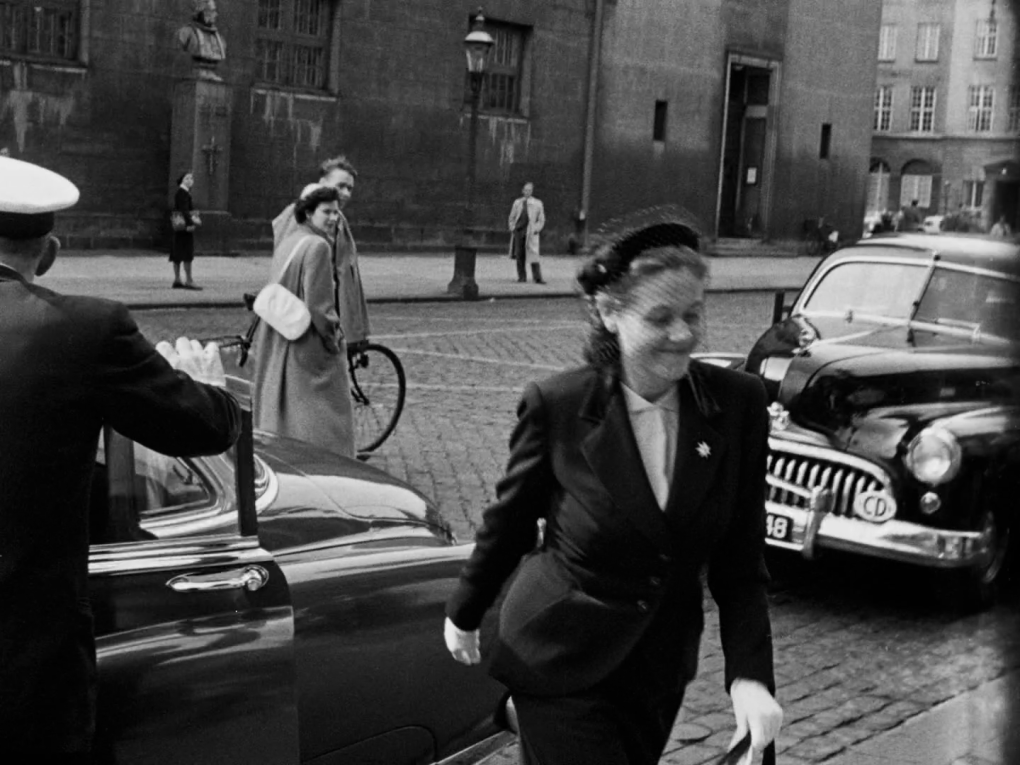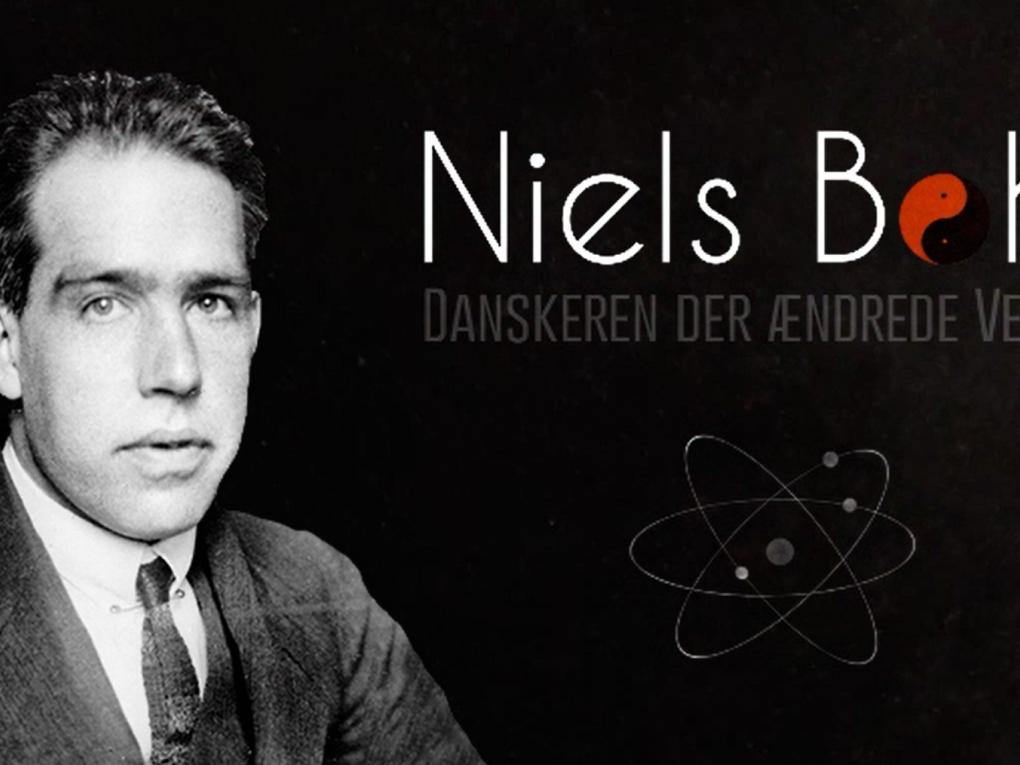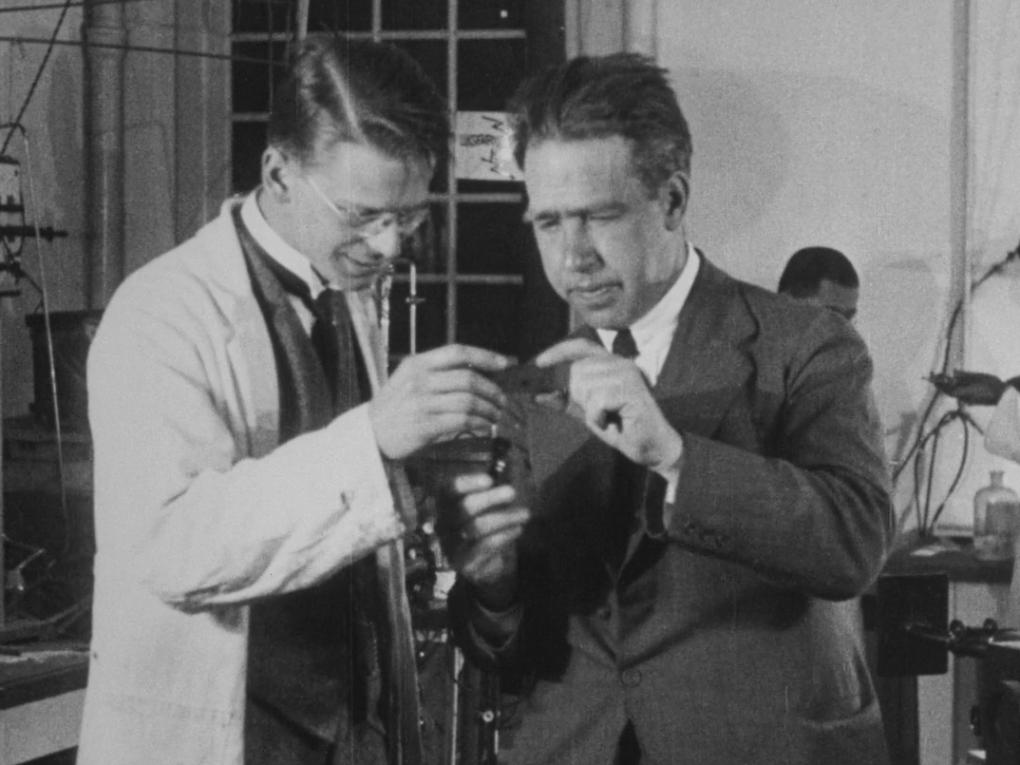Af Lars-Martin Sørensen, forskningsleder og Lisbeth Richter Larsen, redaktør, Det Danske Filminstitut
Niels Bohr var atomforsker, en filosofisk anlagt én af slagsen, og familiefar. Han var verdenskendt i sin samtid, vært for et utal af internationale kongresser og gæst ved lige så mange verden over. Han blev fejret på sine runde fødselsdage i Carlsbergs æresbolig, hvor han boede, og så var han en kendis og kulturpersonlighed, der blev inviteret til alskens officielle arrangementer.
Denne filmsamling favner hele Niels Bohrs liv med regulære portrætfilm, små reportager og nogle lidt skramlede private optagelser. De tre undervisningsfilm om kvantefysik bidrager med en levende og visuel formidling af et meget svært tilgængeligt stof – og det er lige præcis dét, filmmediet kan!
Læs resten af artiklen under filmserien
Virkelighedens mindste byggesten
Nogle af de mest banebrydende naturvidenskabelige opdagelser blev gjort af verdens førende atomforskere, som Max Planck og Albert Einstein, i første halvdel af det 20’ende århundrede. Helt fremme blandt dem var Niels Bohr, som havde sat sig for at forstå og beskrive atomets opbygning. En opgave med et svimlende perspektiv, fordi hele den fysiske virkelighed, der omgiver os, består af atomer. At kende atomets opbygning er derfor at gøre sig til hersker over naturens store kræfter, som Bohr formulerede det.
Det er en velafprøvet videnskabelig metode at skille tingene ad i deres mindste bestanddele, når man vil begribe noget. Men hvordan skiller man noget ad, som ikke kan ses, noget så småt, at selv det kraftigste mikroskop er blindt? Et knappenålshoved består af mindst 100 trillioner atomer. Valser man knappenålshovedet ud til samme tykkelse som et atom, vil det kunne nå 600 gange rundt om Jorden. Det forklarer Børge Høst i sin film om moderne atomforskning, En ny virkelighed, der er tilegnet Niels Bohr.
At tænke højt og tale sammen
I Ole Johns portrætfilm Niels Bohr (1985) hæfter flere af Bohrs tidligere kolleger sig ved den frie, legende og nærmest spøgefulde atmosfære, der herskede blandt unge forskere fra hele verden på Institut for teoretisk Fysik – siden 1965 ’Niels Bohr Institutet’ – under Bohrs ledelse. Han udvalgte sig typisk en yngre kollega, som så var hans samtalepartner gennem en hel dag. En af samtalerne fortsatte en aften, hvor Bohr forfulgte en tanke helt ind i den sporvogn, der skulle køre ham hjem til æresboligen på Carlsberg. Hans samtalepartner skulle ikke med sporvognen, men Bohrs tale fortsatte uanfægtet af sporvognens køreplan og hans yngre kollega, som stod på gaden ved stoppestedet. Og hvad gjorde sporvognsføreren? Han ventede pænt med at sætte vognen i gang, til den store forsker havde fulgt sin tanke til dørs og afrundet samtalen.
Måske udsprang den flydende talestrøm af, at Bohr i sin søgen efter erkendelse erfarede, at sproget ikke slog til. Han kæmpede ikke kun med at begribe det nye forskningsfelt med tankens kraft, men også med at finde ord, der kunne indfange det, som ingen havde beskrevet før ham. Man mærker Bohrs tumlen med sproget i Jens Henriksens helt særegne film Niels Bohr (1952), hvor han i en længere enetale gør status over sit liv og forskning. Her taler han med en blid, afdæmpet, næsten melankolsk stemmeføring direkte til kameraet i lange, lidt vævende sætninger, som var han konstant på jagt efter de helt præcise formuleringer.
Bohrs dilemma
Ud over at fortælle om Bohrs store videnskabelige landvindinger fremstiller filmene også dilemmaer og modsætninger i Bohrs person, liv og forskning: en stor mand med en yderst beskeden, nærmest ydmyg fremtoning, der år ud og år ind lidenskabeligt forfølger tanker og erkendelser til store resultater; en legende og uformel leder af et forskningsmiljø, hvis omdrejningspunkt er karakteriseret ved den største alvor – uden Bohrs forskning, ingen atombombe, som han brugte halvdelen af sit liv på at forhindre brugen af. Han stod fadder til komplementaritetsprincippet, som består i, at man i visse sammenhænge må forlige sig med to indbyrdes modstridende forklaringer på et og samme fænomen for at opnå en dækkende beskrivelse.
Alle disse modsætninger var indlejret i Bohrs videnskabelige og filosofiske tænkning, hvilket han så smukt lagde frem ved at vælge yin & yang – de komplementære modsætninger i perfekt harmoni – som symbol på sit våbenskjold.
Lars-Martin Sørensen og Lisbeth Richter Larsen | 06. oktober 2022























